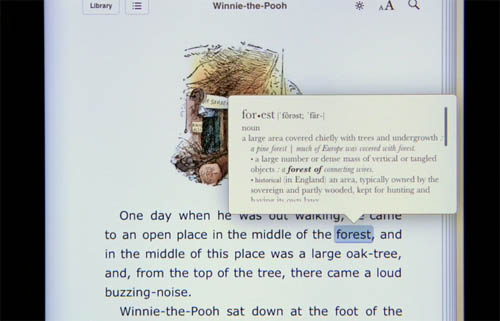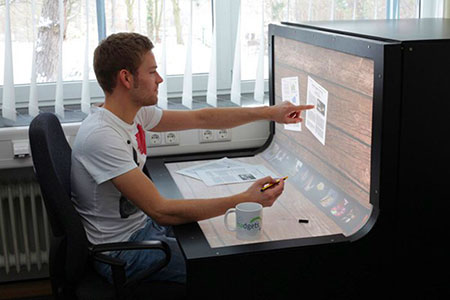One year or thereabouts past the introduction of the iPad, it seems safe that the term ‘touch computing’ has a sound footing in devices that are readily available in both the large, small, and medium sized flavor (Samsung galaxy). Contrast this to ‘normal’ computers and other sorts of remote controls which I supposed can be be called ‘button computing’ (which leaves out ‘dial’ computing I suppose). There’s no doubt it opens opporrtunities to design new kinds of interaction.
So what did the iPad do that is truly new? I’m getting a fair amount of clues from some apps (Popplet, Flipboard, Color Splash, Twitter, Keynote) but it is clear that it is different than how you would use the smaller device, but not clear what the ‘sweet spot’ is for users yet. Just like the VR gloves we’ve seen for ages, It is truly a new input device, people can directly interact with information in a way that feels very different. And size does matter,. the extra space makes ‘meta’ gestures like swipe and some 3 fingered actions easier. The key to understanding the future is how to create information on these devices. Will it be to play a virtual violin on stage? Likely not.
The iPad has plenty of attraction but questionable affordance, a term Donald Norman appropriated to describe the intersection of a product and how someone percieves its use. For example: In a recent fit of carpentry, I had the desire to cut a shape out of wood. At the hardware store I was tempted to solve the problem with a new ‘all-in -one tool’ that could both cut shapes as well as a myriad of other tasks (as seen on TV). Alternately, there was a jigsaw, the ‘traditional’ tool for the task. I purchased the all-in-one tool, found it to be too hard to use, and ended up with the jigsaw.
Problematically for users, what kind of task you want to complete is a tough call. Computing in general never really purports to afford the user any particular kind of solution. Even though “People don’t want a quarter inch drill, they want a quarter inch hole” says Theodore Levitt. The machine’s flexibility is really the value proposition. Outside of the rather large realm of what is possible through an internet browser, we certainly can isolate word processing, data processing, and message processing tasks (email) as being well suited to a traditional computer setup (screen and keyboard). Less traditional uses such as gaming and most online activities are about selection, pointing and clicking, and take place in that oddly separate peripheral, the mouse.
Other computer tasks such as video and image editing may even have created a new peripheral, the drawing tablet, or the dedicated keyboard with more prominent buttons to emphasize the activities common to these tasks. While many people find copy/paste keyboard shortcuts easy to remember, I think its fair to characterize that dedicated buttons are a variant on a control interface of a computer and in a sense a ‘hack’, but an useful one for educated users. They do not usually announce themselves, so this can be considered a barrier to entry. In general custom buttons are sort of a dirty solution to user control, regard the general hatred of remote controls as evidence.
And speaking of dedicated buttons, we can include smart-phones in the discussion of computing. I’ll admit a real feeling of frustration/stupidity when trying to ‘unlock’ a cellphone and not being able to locate the ‘function’ key it was so adamantly asking me to push. I had to call the phone company (on my iPhone) to find out what one that was (its in the lower left corner, oddly not mentioned in the owners manual). Which brings us to the newer world of capacitance screens and being able to merge a bit of the button pressing interface with an actual tactile interaction. Bringing it closer to how we make selections on a website, by poking at it.
As innovations go, there are certainly people that value a physical keyboard, how ever divorced it is from the full size version, for the minimum reason of being able to transfer their skill in typing to another realm. Personally, I’m waiting this year for voice activation, and computers understanding contextual multitasking through voice we saw demoed back in the 90’s So, the iPhone and capacitive screens offered a slight variation on the mouse and keyboard, replacing them with virtual counterparts, Steve Jobs legendary button phobia is well earned, outside of a QUERTY keyboard, each variation in button function encourages variation among programs and general lack of learnability. The iPhone with virtual buttons and a sparser screen helps mitigate the problem, and is teaching programmers to be thoughtful in button use and placement.
Manipulating info on a small screen like the iPhone was intended to translate well to the large screen of the iPad. As of this writing i think it’s more of a case that as Diddy once said, "mo’ screen mo’ problems."he bigger screen does allow for webpages to be displayed in a way that doesn’t require an alternate design as is popular on the iphone. I noticed right away that clicking to navigate is not quite ‘fun’ on the iPad, and that if you are used to doing lots of selections, the iPad doesn’t handle linear navigation as effortlessly as a computer screen. We are perhaps too used to multiple screens, multiple tabs and multiple open windows and the forced focus of an iPad seems like a step backward.
However there are some experiences that are quite surprising, the processing power and large screen make virtual musical instruments quite enjoyable like the aformentioned virtual violin, Korg vintage synthesizers with virtual patch cords and dials work great. Most single window interfaces are quite enjoyable on the iPad. But the innovation just arising from efforts like flipboard and twitter is what I’ll call a ‘sliding’ interface. When you select something in a list, the chosen item then ‘slides’in a new pane containing the information. This slightly covers the list, and can be slid out of the way or further slid around to highlight details. By avoiding a linear path, these interfaces start to show where innovation in how we read or consume on this new device. Unlike ‘picture in picture’, the real innovation is to keep context much like top or side navigation, but to overlay a new contextual layer.
This slightly covers the list, and can be slid out of the way or further slid around to highlight details. By avoiding a linear path, these interfaces start to show where innovation in how we read or consume on this new device. Unlike ‘picture in picture’, the real innovation is to keep context much like top or side navigation, but to overlay a new contextual layer.
And who said consumption is all that great? iPad is certainly a natural in consumption. Books, magazine and video are all delightful, and certainly the main use people will have for the device. Out of the box, there is just something sci-fi about laying a screen on your table or lap and watching a movie. The legacy of televisions being heavy cathode ray tube containing boxes has not been entirely erased from memory. Even the relative position of a laptop screen doesn’t have the same wow factor as the iPad. Also the stamina of the battery and the somehow missing feature of the Kindle being able to read in the dark next to a sleeping partner, is an easy win. I also use and appreciate the computer aspect of the book reader, looking up references inline in dictionary or Wikipedia is also very futuristic and useful.
Also the stamina of the battery and the somehow missing feature of the Kindle being able to read in the dark next to a sleeping partner, is an easy win. I also use and appreciate the computer aspect of the book reader, looking up references inline in dictionary or Wikipedia is also very futuristic and useful.
I’m a bit fearful that iPad 2 will incorporate a camera. As a photo viewer, the iPad is great, a perfect companion (with the sold-separately camera connector) on a trip. But as a large viewfinder to a tiny camera, I think it’s a step in the wrong direction. It would, if rear-facing, perhaps revive the interest in augmented reality, now only being slightly resuscitated by the translator program Word Lens. So in conclusion, people will want to touch their information, layers are the way forward, and consumption is good, but to really shine, its figuring out a way to create will create change.

